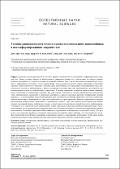| dc.contributor.author | Василевич, Ю. В. | |
| dc.contributor.author | Остриков, О. М. | |
| dc.coverage.spatial | Минск | ru_RU |
| dc.date.accessioned | 2024-11-22T11:46:10Z | |
| dc.date.available | 2024-11-22T11:46:10Z | |
| dc.date.issued | 2017 | |
| dc.identifier.citation | Василевич, Ю. В. Условие равновесия остаточного краевого клиновидного нанодвойника в постдеформированном твердом теле / Ю. В. Василевич, О. М. Остриков // Наука и техника. – 2017. – № 4. – С. 335–342. | ru_RU |
| dc.identifier.uri | https://elib.gstu.by/handle/220612/39580 | |
| dc.description.abstract | Выведено условие равновесия остаточного краевого клиновидного нанодвойника в деформированном твердом теле. Вывод условия основан на необходимости равновесия баланса сил, действующих на каждую двойникующую дислокацию со стороны остальных дислокаций двойника. При этом не учитывали дислокационную структуру и напряженное состояние у устья нанодвойника. Использовали результаты теории дислокаций, полученные в рамках теории упругости и механики сплошных сред. Рассматривали составляющую результирующей силы, действующую в плоскости двойникования. в рамках допущения отсутствия движения двойникующих дислокаций в перпендикулярном плоскости двойникования направлении. В модели принимали дискретное распределение двойникующих дислокаций на двойниковых границах. Для уменьшения громоздкости расчетов рассматривали ограниченное число двойникующих дислокаций и принимали допущение о малости величины винтовой составляющей вектора Бюргерса. т. е. рассматривали краевой нанодвойник. Д.ля уменьшения количества уравнений в системе условий равновесия использовали симметричность сдвиговой компоненты тензора напряжений. Вводили ограничение на порядок расположения двойникующих дислокаций на двойниковых границах. При этом полагали расположение пар двойникующих дислокаций разных двойниковых границ в одной плоскости, перпендикулярной плоскости двойникования. Учитывали, что в одной плоскости двойникования может находиться только одна двойникующая дислокация. Расчетами показано, что в идеальном ненагруженном кристалле возможно устойчивое и неустойчивое равновесие краевого нанодвойника. Устойчивое равновесие обеспечивается выстраиванием двойникующих дислокаций в стенку. Это приводит к исчезновению двойника в результате аннигиляции дислокаций границ двойника с его дислокациями у устья. Для обеспечения неустойчивого равновесия клиновидного краевого нанодвойника необходимо, чтобы вдоль длины двойника расстояние между двойникующими дислокациями равнялось межплоскостному расстоянию. | ru_RU |
| dc.description.abstract | An equilibrium condition of residual edge wedge-type nanotwin in a deformed solid body has been derived in the paper. The condition conclusion is based on the necessity to ensure an equilibrium of force balance acting on every twinning dislocation from the side of the rest twin dislocations. In this case dislocation structure and stress condition at nanotwin mouth have not been taken into account. Results of dislocation theory obtained in the framework of elasticity theory and continuum mechanics have been used in the paper. The paper has considered a component of the resultant force acting in a twinning plane under an assumption that there is no motion of twinning dislocations in the direction which is perpendicular to the twinning plane. The following condition has been made in the model: a discrete distribution of twinning dislocations at twin boundaries. In order to reduce cumbersome calculations a limited number of twinning dislocations has been considered in the paper and an assumption has been made about small value of a helical component in the Burgers vector, in other words the paper has considered an edge nanotwin. In order to decrease a number of equations in the system of equilibrium conditions a symmetric property of a shear component in a stress tensor has been used in the paper. The paper contains description how restrictions on the order of twinning dislocation arrangement on twin boundaries have been imposed. In this case it has been assumed that an arrangement of twinning dislocation pairs in different twin boundaries is in one plane which is perpendicular to the twinning plane. It is necessary to keep in mind that only one twinning dislocation can be located in one twinning plane. Calculations have shown that it is possible to ensure a stable and unstable equilibrium of an edge nanotwin in an ideal unloaded crystal. Sustainable balance is provided by alignment of twinning dislocations in a wall. This leads to a twin disappearance due to annihilation of twin boundary dislocations with its dislocations at the mouth. In order to ensure an unstable equilibrium of a wedge edge nanotwin it is necessary that the distance between twinning dislocations along the length of the twin is equal to interplanar distance. | |
| dc.language.iso | ru | ru_RU |
| dc.publisher | БНТУ | ru_RU |
| dc.subject | Механическое двойникование | ru_RU |
| dc.subject | Остаточный нанодвойник | ru_RU |
| dc.subject | Условие равновесия | ru_RU |
| dc.subject | Двойникующая дислокация | ru_RU |
| dc.subject | Краевой двойник | ru_RU |
| dc.subject | Mechanical twinning | ru_RU |
| dc.subject | Residual nanotwin | ru_RU |
| dc.subject | Equilibrium condition | ru_RU |
| dc.subject | Twinning dislocation | ru_RU |
| dc.subject | Edge twin | ru_RU |
| dc.title | Условие равновесия остаточного краевого клиновидного нанодвойника в постдеформированном твердом теле | ru_RU |
| dc.title.alternative | Equilibrium Condition of Residual Edge Wedge-Type Nanotwin in Post-Deformed Solid Body | ru_RU |
| dc.type | Article | ru_RU |
| dc.identifier.udc | 539.3 | |
| local.identifier.doi | 10.21122/2227-1031-2017-16-4-335-342 | |
